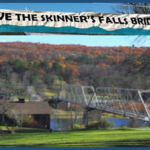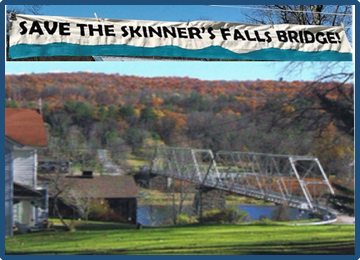
Advocacy Day, Jan. 28, to Reduce Plastic Waste in NYS
December 3, 2024
PennDOT Meeting on the Skinners Falls Bridge Feb. 11
January 26, 2025DCS is actively and strongly defending the Skinners Falls Milanville Bridge from destruction by PennDOT, using their own data.
As detailed in our 1/2/2025 comment letter, PennDOT’s claims of rapid deterioration are not supported by the data available to DCS. To the contrary, measurements of the NY abutment/wingwalls, which PennDOT has focused on, show no movement for at least the past year. As of May 2023, PennDOT’s consultant (AECOM) issued a report confirming that the Bridge could still be rehabilitated. PennDOT’s sudden and swift push to demolish the Bridge, without a clear factual basis, circumvents the Environmental Rights Amendment, Section 106 of the National Historic Preservation Act, and the National Environmental Policy Act, and sets a destructive precedent for all historic bridges in PA.
The proposed destruction of the Bridge must be halted, and Bridge rehabilitation finally made a priority.
Download the DCS 1/2/2025 comment letter as a pdf.
Download excerpts from the October 2024 AECOM Inspection Report as a pdf. The measurements show no changes in 2024, and in some cases, no changes over several years.
Download the DCS Press Release as a pdf.
Hear DCS Director Arrindell and Cynthia Nash discuss the reasons for saving the Skinners Falls Bridge on Radio Catskill’s Let’s Talk Vets (starting at 39:15).
Excerpts from the DCS 1/2/2025 comment letter follow.
Damascus Citizens for Sustainability (“DCS”) submits this comment letter objecting to PennDOT’s proposed destruction of the National Register-listed Skinners Falls Bridge (“Bridge”), which is also part of the National Register-listed Milanville Historic District. The Bridge is one of only three remaining pin-connected Baltimore through-truss bridges in the entire Commonwealth of Pennsylvania. DCS is a consulting party and does not agree that the only resolution to the current situation is complete demolition of the Bridge.
PennDOT has not provided sufficient information to evaluate or substantiate its claim that the only alternative here is bridge destruction, which is an adverse effect on historic resources under Section 106 of the National Historic Preservation Act (“Section 106”). PennDOT fails to specify what structural aspects of the Bridge have deteriorated so badly in the past year (as opposed to PennDOT’s backlog of Bridge maintenance) that it can only pursue emergency demolition. The information presently available to DCS shows that the Bridge can still be rehabilitated, and could have been rehabilitated at any point in the last two or more decades.
The ultimate obstacle to the Bridge’s existence and rehabilitation is and always has been PennDOT and its twenty-plus year failure to prevent the Bridge from deterioration and to restore it. Critical Bridge maintenance issues that PennDOT ignored for decades are now, inexplicably but with extreme haste, PennDOT’s basis to demolish the Bridge. To allow PennDOT to destroy the Bridge on such flimsy, disingenuous reasoning and its own obstinate negligence establishes a destructive precedent for every historic and other bridge in the Commonwealth. The demolition must be halted, and work finally undertaken to stop the Bridge’s deterioration, and advance rehabilitation.
********************
On December 6, 2024 the PennDOT District 4-0 executives decided that due to a number of factors, including the continued deterioration of the abutments and concern it will be accelerated by the freeze-thaw cycle, problems associated with having a causeway in the water during the worst of the winter weather, worker safety concerns with careful disassembly, and the need to be out of the water and surrounding New York land by the beginning of the summer recreation season, the bridge will be demolished rather than removed in a way that allows for future rehabilitation consideration. This will result in an adverse effect to historic properties.
It is presently unclear what data, studies, or analyses the District 4-0 Executives used to make their decision. No document posted to PATH is dated prior to the December 6, 2024 decision. As explained in this letter, PennDOT has provided no analysis to support its fear that the NY abutment will imminently and catastrophically collapse. This black hole of information and analysis is contrary to Section 106, which requires that the public be able to comment in an informed manner throughout the process.
This is not the first time that PennDOT has left the public and consulting parties in the dark. PennDOT has repeatedly failed to meet its Section 106 obligations in this “emergency” situation.
********************
Thus, as with previous information, the data and studies the District 4 executives used to justify demolition of the Bridge remain a mystery, contrary to Section 106 and the National Environmental Policy Act. This, however, is not due to a lack of studies. The Upper Delaware Council (“UDC”) has repeatedly noted that PennDOT has spent approximately $4 million dollars (not including money spent in 2024) on studies on the Bridge. Where are those studies?
AECOM’s October 7, 2024 inspection report does little to advance PennDOT’s desire for full bridge demolition. Almost all of the information is a summation of twenty-plus years of inspection reports. AECOM’s October 7, 2024 report does not justify demolition. Rather, it is an indictment of PennDOT’s repeated deferred critical maintenance, which twenty years of inspection reports document. Thus, nothing in AECOM’s October 7 inspection report substantiates the fear of a catastrophic collapse. The report still identifies a path forward for Bridge rehabilitation in the form of the work PennDOT has sloughed off for decades. This is in addition to AECOM’s May 2023 HBRA Phase I report confirming rehabilitation is possible.
PennDOT has watched the cracks in the Bridge abutments and wingwalls widen over a twenty-year period. Even in November 2024, when PennDOT proposed to dismantle the Bridge, it claimed it was doing so merely “out of an abundance of caution.” How is it that suddenly now, not even a month later, the Bridge is too unstable? PennDOT has no answer.
********************
PennDOT’s dramatic and rushed schedule during the busiest holiday season of the year when the public is focused elsewhere is highly suspect. Although bridge demolition would certainly achieve what to the public appears to have been PennDOT’s goal all along – a 40-ton, two-lane bridge out of character and unneeded for the area – it directly contravenes the procedural requirements of Section 106 and NEPA, and violates the Environmental Rights Amendment. “The people have a right . . . to the preservation of the natural, scenic, historic and esthetic values of the environment.” Pa. Const., art. I, § 27, cl.1. Absolutely nothing about how PennDOT has handled the Skinners Falls Bridge situation lives up to that mandate. PennDOT has no strategy on how it plans to preserve the historic, esthetic, and scenic values that the Bridge contributes to Milanville, Cochecton, and to the Upper Delaware Wild and Scenic River. Its only strategy is completely contrary to the constitutional command.
Ultimately, the emergency to the public is PennDOT. PennDOT chose, over decades, not to fix the known problems on the Bridge that it now claims are the reason it needs to destroy the Bridge in full. It repeatedly chose not to pursue a full rehabilitation of the Bridge. It inexplicably accepted the 2020 inspection report that downgraded necessary repairs that PennDOT had deferred year-after-year. In 2021, the public perception was that PennDOT sought to force it to accept a bridge replacement, which the public – as the record shows – clearly rejected in favor of saving and rehabbing the Bridge. PennDOT then did absolutely nothing to prevent the Bridge from further decrepitation. Nothing.
********************
PennDOT, with the approval of the Governor, is setting a destructive precedent for every historic and other bridge in the Commonwealth. That precedent is: wait, watch, and document as the bridge falls apart, year after year, until PennDOT can declare an emergency to circumvent established Section 106, NEPA, and other procedures to pursue the goal it wants – rather than the outcome: (a) best suited for the community; (b) that the community has clearly stated it wants; and (c) that fulfills the requirements of Section 106, NEPA, and the Environmental Rights Amendment.
PennDOT’s race to demolish the Bridge is not just unconstitutional, but also fiscally irresponsible. It has paid millions of dollars to private consultants for “studies” while the Bridge decayed further, and maintenance costs only rose decade after decade. DCS understands that funding for roads and bridges is not always easy to come by. However, DCS has witnessed a pattern of PennDOT and its private consultants dragging out bridge project processes for decades, spending countless taxpayer dollars, until PennDOT finally gets what it wants, which is usually the destruction of another historic bridge. Pond Eddy Bridge is only one recent example.
The people of Pennsylvania deserve better. This community deserves better. However, once again, the Commonwealth of Pennsylvania has abjectly failed them. The obliteration of the historic Skinners Falls Bridge must be halted, and the Commonwealth of Pennsylvania (including PennDOT) must be held to account for its continued destruction of historic, natural, scenic, and other resources that are integral to the fabric of communities, their economies, and their collective joy and memory. That accountability must include: (a) a reversal of PennDOT’s planned Bridge destruction; and (b) proper rehabilitation and restoration of the Bridge, including immediate prevention of further Bridge decay using known available funds and expertise.
Your donation today helps DCS fight to save the Skinners Falls Bridge



